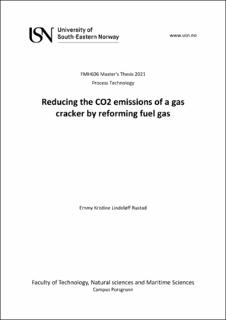| dc.description.abstract | With the rising need for CO2 reduction and the pressing two-degree target there is no doubt that measures must be made in the chemical process industry. Ethylene production by steam cracking is a mature and widespread technology. In addition, to being one of the most energy intensive processes, global emission from steam cracking exceeds 300 million tons of CO2 every year.
This report presents the decarbonization options of the ethylene production, as well as production pathways from hydrocarbons to hydrogen. The main goal is to investigate if fuel replacement by reforming the current fuel to only hydrogen can cover the energy demand in a steam cracking furnace for ethylene production.
The selected method for hydrogen production is an autothermal reforming process (ATR) with integrated pre-combustion CO2 capture. The process is simulated in Aspen HYSYS and partly maximized for the hydrogen production. The optimization is conducted as a result of examining five different configurations and nine case studies, including the most important input parameters.
The result was a system with a pressure of 2290kPa (in ATR), ST/C-ratio of 2, O2/C-ratio of 0.52, and an inlet temperature to the ATR of 750℃. The inlet temperature to the high and low-temperature water-gas-shift reactors was 300℃ and 175℃, respectively. The inlet flow is 514.2kmole/h methane and 2976.3kmole/h hydrogen, where 95mol% of the hydrogen is separated prior to the reformation process. The simulation did not result in a system that can cover the energy demand by only reforming the current fuel to the cracking furnace. To cover the gap between the simulated and desired flow of hydrogen, an inlet flow of ethane was added to the process. By adding 22kmole/h of ethane, a sufficient amount of hydrogen flow was reached. Additionally, potential steam export was found to be 21.3MW, excluding the heat required for CO2 and H2 separation unit(s).
Overall evaluation is that fuel replacement in industrial furnaces can have a significant impact towards decarbonization of energy intensive industries and that reforming traditional fuels containing hydrocarbons to hydrogen shows potential. | |
